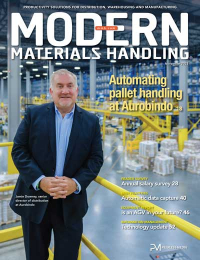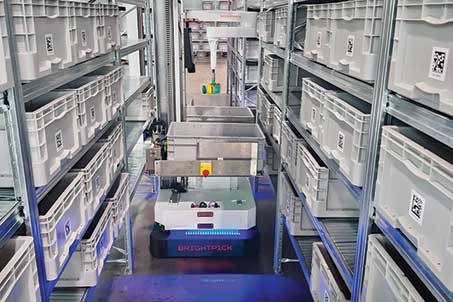Four tech directions to shape distribution center (DC) performance
Yes, warehouse robotics are the biggest thing in automation, but they’re not the only tech to drive efficiencies. Orchestration software, better robot/human collaboration, and the application of computer vision to inventory accuracy all play a role in operational gains.
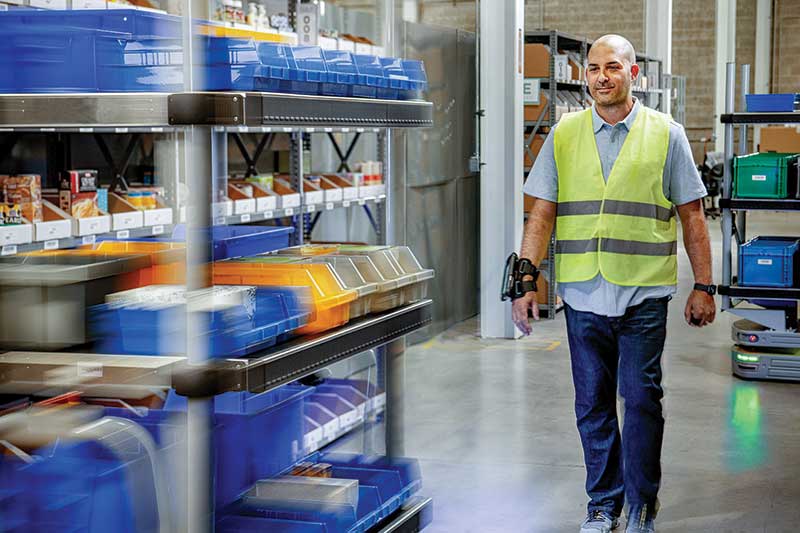
Call it flexible automation or warehouse robotics, but by almost any measure, the highest growth categories in the materials handling world are autonomous mobile robots (AMRs) and smart pick-and-place robotics that make use of artificial intelligence (AI). But that doesn’t mean they’re the only solutions to consider.
The many robotic variants include AMRs that do assistive picking, AMRs that do case handling, and with robotic picking, some solutions autonomously pick eaches or polybags, while others can manipulate cases to automate palletizing or de-palletizing. For certain, robots are the biggest thing to hit warehouse automation in recent years, but the trick is to know which robotic solutions or combination of solutions match operational needs, while having the software to tie everything together.
The other reality to keep in mind is most warehouses have a mix of systems, automated and manual, and most rely on labor—warehouse associates—to get orders out the door, even when robotics allow for smaller teams to do more.
Warehouses also have constant inflows and outflows of inventory that need to be received, stored and shipped accurately and in a way that minimizes costs. These needs have given rise to solutions aimed at coordinating robots with people, and in tapping vision technology and AI to understand inventory flows.
Here are four trends to watch. All involve robotics or AI, and could shape the way more warehouses or plants with complex materials handling can amp up operational performance.
1. Orchestration platforms
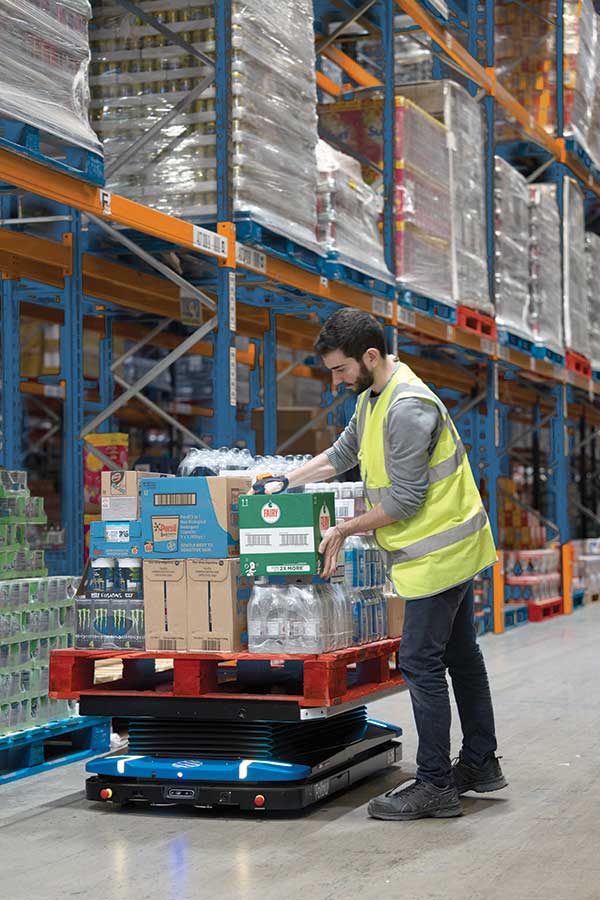
Wearables scanner provider ProGlove sees its integration capabilities as an enabler of effective human and robotics collaboration.
A sign of just how prevalent robotics has become is that now integrating different robot solutions with each other and with traditional automation, like conveyors or automated storage and retrieval systems (AS/RS), has become a software solution space. Analyst company Gartner calls this segment multi-agent orchestration or “MAO” platforms.
Dwight Klappich, research vice president and fellow with Gartner, says the need for MAO platforms is driven by companies that already have robotics and are not just looking to scale up one solution, but get multiple ones working together, while being able to integrate them with existing automation. They want the type of tight integration that can be had with traditional systems integration projects, but less hard-coded and rigid.
“They want to be able to bring a different robotics solution in and get them to work together as a holistic system, but they want to maintain that flexibility and adaptability,” Klappich says. “They want integration and orchestration, but they don’t want to be locked in for the next 20 years.”
The MAO platform market is still emerging, Klappich explains, with differing vendor capabilities, though most have a mix of integration mechanisms and business logic to set up workflows that span systems.
“Basically, it’s a layer of software that sits above heterogenous fleets of robots and other forms of automation to orchestrate work and integrate to underlying platforms. If you look at some of the big third-party logistics providers, they’re aggressively adopting robotics, and they are some of the companies at the forefront of this space saying, ‘hey, we’ve got to figure out to connect all these things more easily.’" - Klappich
Orchestration platforms provide integration ease but also fulfillment logic to manage workflows, says Akash Gupta, co-founder and CEO of GreyOrange, which offers an orchestration platform called GreyMatter. The orchestration engine assigns multiple agents to drive work across various areas and material flows. The software also uses AI to see patterns and learn how to make workflows more efficient, while providing dashboards on performance.
The platform can be used to integrate distinct systems into a cohesive flow—such as linking a robotic picking system with sortation AMRs, Gupta says, but there’s also interest in blending different types of robotics within a single process, like order picking, to arrive at a more efficient solution.
“Let’s say a fulfillment center’s order mix needs items that come from racks transported by AMRs, but some other items are in totes,” Gupta says. “With our platform, you could basically look at creating a hybrid station that can combine both racks and totes together, rather than a more complex consolidation process.”
GreyMatter is more than middleware, Gupta adds, because it provides metrics and insights to operations teams. However, Gupta adds, speeding up integration and onboarding of new systems is also crucial. “You can bring in new technologies very easily,” he says. “And, a year later, if you want to bring in another solution, you can pretty much do it right away without changing any of the existing integration, which makes the automation journey much easier.”
As more companies deploy more robotic systems, expect the need for orchestration software to accelerate, agrees John Santagate, vice president of robotics for supply chain software company Körber, which has partnerships with robotics vendors and orchestration capabilities. Robotics hardware innovation continues, he believes, but the end game should be operational improvement.
“The orchestration applications enable interoperable fleets, allowing multiple robotic solutions to execute with awareness of one another, either within the same workflow or simply in the same operating space,” Santagate says. “With this, the appropriate work can be sent to the appropriate robotic solution area, refining operations as we know it.”
2. Labor plus bots
Gupta notes that the agent concept means the orchestration platform also can tie into people-centric systems like voice solutions or pick-to-cart processes. “Robots and people are basically agents that register into GreyMatter and get guidance on how to execute processes and when to execute,” he explains.
Various other solution vendors, some of them with deep roots in robotics, are also touting solutions that eliminate clunky handoffs between robotics and human-centered workflows. Wearables can play a key role here, say vendors.
Paul Travers, president and CEO of Vuzix, says its augmented reality (AR) glasses are well suited to tasks like picking cases to pallets, either on a manual pallet jack or to a pallet on an AMR, because they keep the worker hands-free and can present visual instructions from pallet building software on the glasses.
“Glasses are truly hands free, and they also can provide a visual representation of a process like a pallet build, which helps avoid problems like crushing of lighter products or an unstable load,” Travers says. “It provides a visual representation of exactly where everything needs to go, which supports faster, more accurate builds. That visual element also helps with onboarding.”
OX, a Vuzix partner, offers Vuzix glasses as a wearable for its software, a frontline operations platform that uses AI-enabled workflows to speed up processes like case picking with a pallet jack. According to Tanner Green, OX’s chief product officer, the OX solution is aimed at digitizing and optimizing manual processes, though tapping AMRs for transport is possible.
ProGlove, a provider of smart wearable scanners that fit on a glove, sees its software integration capabilities as supporting rapid creation of workflows that blend human associates and robotics. Ilhan Kolko, ProGlove’s chief product officer, says ProGlove has put intense development effort into its integration layer with AMRs, industrial robots, cobots and other forms of automation.
“We’ve been really growing our connectivity and integration portfolio over the past 18 months, involving 32 software releases, so we can bridge that [human to robot] gap. By enriching our integration portfolio, this ensures it’s easy to have our hardware on the worker, and our software running smoothly together with our partners’ software, to make integrated human and machine workflows happen for the customer.” -Kolko
ProGlove has integrated its wearable scanning with solutions from AMR partners including Locus Robotics, Geek+, iFollow and others, adds Kolko. For instance, ProGlove’s software simplified the integration between its wearable scanners with a goods-to-person AMR fleet from Geek+ at a BMW Brilliance automotive plant in China.
Metadata, like times between scans, can also be shared with robotics solutions to provide a more holistic view of productivity and traffic patterns, adds Kolko. “Our job is to make sure we have an open platform so anyone who has a mix of human resources and automation they want to bring together, they can easily do it,” he says.
At Onward Robotics, formerly known as IAM Robotics, its “Meet Me” solution focuses on coordinating mobile robots with human pickers as independent workflows, using wearable devices from major device vendors to notify workers where to go and what to do next, says Lance VandenBrook, CEO of Onward Robotics. He explains that while AMRs do provide efficiencies versus unoptimized manual picking, time can be wasted in coordination between humans and AMR fleets, which he says the Meet Me system addresses.
Onward Robotics offers AMRs with put-to-light shelving on top, similar in look to some other AMRs. The difference with Meet Me, VandenBrook explains, is that the solution’s algorithms maximize productivity by orchestrating human and AMRs workflows independently, while the system leverages wearables to guide associates on tasks and keep them aligned with the robots. The overall solution provides team-based and individual performance views.
VandenBrook adds that third-party logistics providers (3PLs) are especially interested in solutions that blend AMRs with human pickers in a way that supports pay-for-performance, which he says was a guiding principle for the Meet Me solution.
“You’ve got associates who maybe aren’t enabled to be as time efficient as they could be; and meanwhile in the market overall, operations are starved for labor resources, which is why we want to maximize every second of human resource available,” says VandenBrook.
Smart robotic picking momentum
Brightpick’s robots take on autonomous in-aisle picking as well as other processes for Rohlik Group.
Autonomous mobile robots (AMRs) of various types, like assistive pick robots, rack-to-person AMRs, or large format AMRs that can transport pallets, have seen rapid uptake, but analysts also foresee solid growth for smart robotic picking solutions that come in many forms.
Market intelligence firm Interact Analysis forecasts more than 150,000 picking robots will be installed by 2030, with annual shipments jumping from less than 2,000 in 2022 to just above 50,000 by the end of the decade, driven by rising wages in warehouses, labor shortages, and rapid development of artificial intelligence (AI) and vision technology.
To handle the SKU variability in warehousing, smart robotic picking solutions leverage vision and AI software to give robots the intelligence to pick and place a variety of objects without preprogramming the robot, ranging from small cartons or parcels to cases in smart robotic palletizing and depalletizing solutions.
In addition to smart robotic picking cells, mobile robots are capable of smart robotic picking. Such mobile manipulation robots are being applied to autonomous unloading and loading of cartons from trucks. For example, Dexterity recently announced a collaboration with FedEx on a robotic truck loading application.
A tougher nut to crack has been leveraging mobile picking robots for piece picking from shelving in aisles. However, Brightpick, part of Photoneo Brightpick Group, which also offers 3D vision technology, addressed this challenge and is gaining real-world deployments.
Brightpick offers mobile picking robots that autonomously pick items directly in aisles. But what Brightpick offers is more than robotic picking, explains Jan Zizka, Brightpick’s CEO, since its robots can consolidate and dispatch orders, as well as replenish inventory, as part of an overall fulfillment process orchestrated by Brightpick’s Intuition software.
For in-aisle robotic picking, Zizka says Brightpick Autopicker robots work as a tightly orchestrated fleet, typically between 20 to 50 bots in a deployment.
To simplify the AI challenge, the robots have a mechanism to extract standard totes from shelves, and then pick the needed SKUs from that tote once it’s beneath the robot’s 3D vision camera, leveraging AI to pick and place needed items into an order tote on the other side of the bot. The robots make use of relatively low-cost SCARA arms, and the vision cameras are from Photoneo.
The key to the efficiency of the mobile picking bots, Zizka explains, is they function as a tightly coordinated fleet managed by Brightpick’s software, which provides opportunities to optimize for order throughput and high robot utilization, given a bot is usually close to the next optimal pick.
The software drives replenishment and dynamic slotting, which helps speed up throughput by spreading out fast-moving SKUs to avoid congestion.
The tote-handling design of the Autopickers and the AMR base for mobility allows the robots to be used for order consolidation, dispatch and replenishment roles. In addition, Brightpick offers a bot called Dispatcher for dispatch and order consolidation.
The result is an order fulfillment solution that centers on autonomous in-aisle picking, but also supports order consolidation, final buffering, and dispatch to packing and shipping. “We offer an end-to-end fulfillment solution, not just the picking,” notes Zizka.
Brightpick’s users include Rohlik Group, one of the largest e-grocers in Europe, which in June completed a nine-month pilot of Brightpick’s solution at its fulfillment center in Prague, Czech Republic.
In July, Rohlik went live with the system at one of its fulfillment centers in Munich, Germany, with plans to rollout it out at other DCs in Germany in late 2023 and 2024. The deployments span picking, consolidation and dispatch of orders.
Zizka believes warehouse robotics and the AI-based software need to take on these broader roles and work cohesively with other processes in place, like manual pick-to-cart zones or existing automation.
For example, with Rohlik, one of its warehouses uses a robotic automated storage and retrieval system from AutoStore, which will continue to be used, with Brightpick Dispatcher robots able to visit its workstations to gather goods and consolidate them with goods needed to complete orders.
“The ability to automate order consolidation is a big deal, because doing it manually is labor intensive and tends to be chaotic,” Zizka says. “When you have robots and software such as our Brightpick solution that not only automates and manages this consolidation step, but also handles final buffering and dispatch, then it becomes more of an end-to-end system.”
3. Vision & inventory
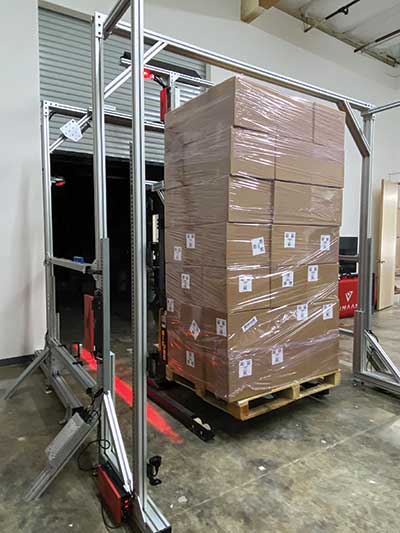
Another area of innovation is the use of computer vision technology and AI applied to inventory tracking and visibility to avoid problems like stock outs in forward pick areas.
If a facility relies only on manual bar code scanning to track inventory and feed data into systems like warehouse management systems (WMS), what typically happens is errors, unless the operation is willing to scan each and every pallet and case coming in while visually inspecting for issues like crushed cartons or cases, says S.K. “KG” Ganapathi, CEO and founder of Vimaan, which offers computer vision and AI solutions aimed at 100% inventory accuracy.
Vimaan’s solution set makes use of computer vision to automatically capture data on inventory at key points in a warehouse, including at receiving docks, in putaway, for cycle counting, or in packing and shipping areas. The computer vision and other sensors Vimaan uses can be deployed in a portal setup at dock doors or on hardware that allows the vision technology to be attached to lift trucks.
The gear doesn’t have to be everywhere, just at select points where key inventory events naturally take place, says Ganapathi, in a way that blends the data capture with natural materials flow.
This stream of data feeds into Vimaan’s AI-enabled software and continuous learning model that makes sense of the data to detect issues like pallets that are short on quantity, or damaged goods, explains Ganapathi, in a way bar coding can’t, to avoid problems like shortages.
“The costs of not having that true visibility and understanding what’s being received and other inventory events, is actually very high,” Ganapathi says.
Ganapathi adds that while it’s possible to achieve adequate inventory control through rigorous bar code scanning, human inspection and manual quality checks, such brute force carries an operational cost. “Much of the base ROI for what we offer comes from the fact that we will reduce the number of people required for these inventory quality control tasks,” he says.
About 20 sites are using Vimaan’s solutions, which provides a digital twin view into where inventory sits in a warehouse. Other vendors also are applying computer vision and AI to inventory visibility, including Kargo, which applies its solution at dock doors.
4. Robotic frontiers
Robotics innovations still matter, even with advances in other areas, though with robotics the software capabilities often set vendors apart. Overall, there continue to be more types of AMR solutions, such as sortation AMRs or autonomous case handling AMRs. Other frontiers exist, with vendors making progress in areas like in-aisle autonomous picking (see box), or humanoid robots from startups like Agility Robotics or Apptronik.
As Santagate observes, some use cases remain relatively untapped for robotic applications. “Currently, most AMRs are indoor applications, leaving immense opportunity for outdoor mobile robotic applications, such as yard management or shuttling between buildings,” he says.
However, Santagate adds, outdoor robotics faces environmental complexities that crop up outside the four walls. “In the building, you have a structured and semi-static environment, offering a mapped-out area where the robots can navigate with a sense of confidence and understanding. When you leave the building, the environment is more subject to change and therefore unpredictable for robots. This makes the ability to do localization far different.”
Santagate also expects to see more uptake for autonomous lift trucks, given the many workflows manual trucks are used for, and immense needs around pallet lifting and handling. “Every warehouse worldwide leverages these technologies, from fork trucks to stackers, but there’s still room for innovation, and I suspect this sector will be the next growth lever.”

Article Topics
GreyOrange News & Resources
Autonomous mobile robots (AMRs) on a mission GreyOrange demonstrates results-driven robotics GreyOrange closes on $135 million in growth financing GreyOrange and Hai Robotics dynamic partnership addresses automated robotic fulfillment Is an automatic guided vehicle (AGV) in your future? Four tech directions to shape distribution center (DC) performance GreyOrange announces Suneel Krishnaswamy as new CPEO More GreyOrangeLatest in Materials Handling
Geek+ and System Teknik deploy PopPick solution for pharmacy group Med24.dk Beckhoff USA opens new office in Austin, Texas Manhattan Associates selects TeamViewer as partner for warehouse vision picking ASME Foundation wins grant for technical workforce development The (Not So) Secret Weapons: How Key Cabinets and Asset Management Lockers Are Changing Supply Chain Operations MODEX C-Suite Interview with Harold Vanasse: The perfect blend of automation and sustainability Consultant and industry leader John M. Hill passes on at age 86 More Materials HandlingAbout the Author
Subscribe to Materials Handling Magazine

Find out what the world's most innovative companies are doing to improve productivity in their plants and distribution centers.
Start your FREE subscription today.
April 2024 Modern Materials Handling

Latest Resources


